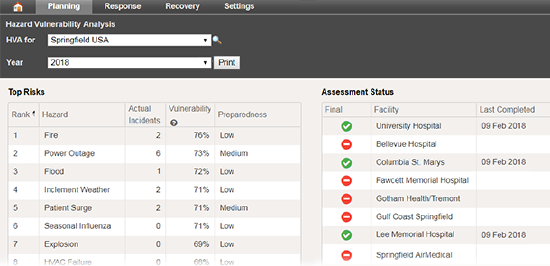The Hazard Vulnerability Analysis (HVA) is an emergency preparedness tool for evaluating the likelihood and estimating the impact of hazardous situations. Results of the analysis are used to guide preparedness efforts for an individual facility, health system, facility group, or coalition. Additionally, HVAs are often used as a compliance measure. Some facilities, such as hospitals, are required to complete HVAs annually to demonstrate compliance with the emergency preparedness regulations for their industry.
Assessment Steps
Accessed through the Planning menu, a wizard-like process guides administrators with appropriate permissions through completion of an HVA in three main steps. The process entails:
- Associating hazards with actual incidents
- Evaluating the threat of hazards
- Reviewing and finalizing the assessment
By associating hazards with actual incidents, the HVA tool enumerates the occurrence of hazards, and then links this information to incidents and their incident response guides (IRGs). The next step involves assessing the probability and impact of hazards, along with the current level of preparedness. Information from these steps is combined and presented as a ranking of hazards, which should be reviewed prior to finalizing the assessment.
Results
Administrators also access and review HVA results through the Planning menu. On the Hazard Vulnerability Analysis page, you can see the status and results of assessments, which provides insight into the risks and vulnerabilities of a facility, health system, facility group, or coalition.
When you select an individual facility at the top, information about assessments appears on the left and Top Risks appear on the right. As appropriate, you can Print, View, and/or Update assessments.

When you select a coalition, health system, or facility group at the top, information about Top Risks appears on the left and Assessment Statuses on the right. Click Print to generate a report, in Portable Document Format (PDF), that can be downloaded or printed, and then signed and submitted to demonstrate compliance.

Top Risks presents ranked hazards, along with the number of actual incidents that occurred during the assessment period, the vulnerability percentage, and the level of preparedness. As a percentage, vulnerability indicates the comparative significance of a hazard. It is calculated based on answers provided on the Threat Evaluation regarding probability, magnitude, and mitigation.
Preparedness, on the other hand, is your response on the Threat Evaluation regarding pre-planning for the hazard. For health systems, facility groups, and coalitions, preparedness identifies the responses from all facilities and indicates the percentage of facilities that provided each response.